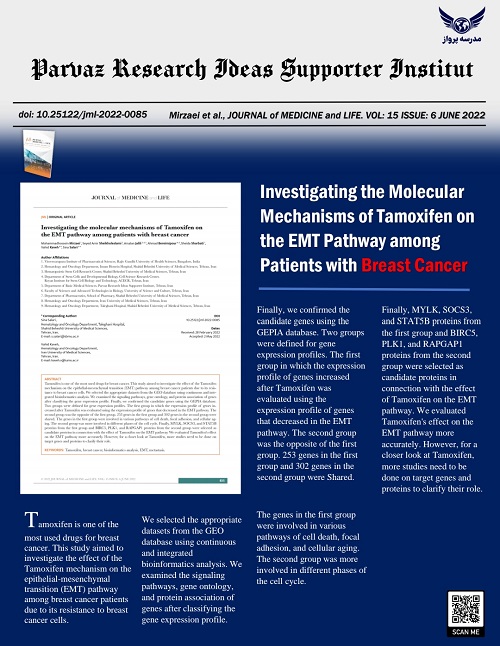
Tamoxifen is one of the most used drugs for breast cancer. This study aimed to investigate the effect of the Tamoxifen mechanism on the epithelial-mesenchymal transition (EMT) pathway among breast cancer patients due to its resistance to breast cancer cells. We selected the appropriate datasets from the GEO database using continuous and integrated bioinformatics analysis. We examined the signaling pathways, gene ontology, and protein association of genes after classifying the gene expression profile. Finally, we confirmed the candidate genes using the GEPIA database. Two groups were defined for gene expression profiles. The first group in which the expression profile of genes increased after Tamoxifen was evaluated using the expression profile of genes that decreased in the EMT pathway. The second group was the opposite of the first group. 253 genes in the first group and 302 genes in the second group were shared. The genes in the first group were involved in various pathways of cell death, focal adhesion, and cellular aging. The second group was more involved in different phases of the cell cycle. Finally, MYLK, SOCS3, and STAT5B proteins from the first group and BIRC5, PLK1, and RAPGAP1 proteins from the second group were selected as candidate proteins in connection with the effect of Tamoxifen on the EMT pathway. We evaluated Tamoxifen’s effect on the EMT pathway more accurately. However, for a closer look at Tamoxifen, more studies need to be done on target genes and proteins to clarify their role

مدرسه پرواز از همه متخصصین زیست بالینی دعوت به عمل می آورد که از طریق بخش پروازی شو فعالیت خود را آغاز نمایند.
آدرس : تهران ، بزرگراه جلال آل احمد ، جنب بیمارستان دکتر شریعتی ، پلاک 10، پژوهشگاه علوم غدد دانشگاه علوم پزشکی تهران


دیدگاهتان را بنویسید